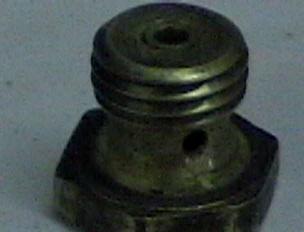

2/6/00Think safety. Working on fuel systems can be hazardous. Work only with good ventilation and away from any source of sparks, flame or high heat. Dispose of any fuel in a proper manner. Check with your local recyclers such as places that accept used oil.
This page is for simple quick repairs of minor problems. If any varishing is found a complete carb overhaul should be performed. If your carb needs a complete overhaul it should be done by an experienced technician. If any rusting or corrosion is found, the carb should be replaced.
Don't alter the settings of the governor when repairing the carb, unsafe overreving or poor performance may occur if the governor speed is altered and the only way to set it correctly is with a tach. Repair is repair. Altering a carb from the way it was built is illegal on engines built since 1995. C.A.R.B. and E.P.A. laws prohibit altering from original any parts or components that are considered related to emission controls.
What we're going to deal with here is the delivery of fuel from the fuel tank to the initial stages of flow through the carb. Any further repair should be done by an experienced technician.
{}][{}[]{}[]{}[]{}[]{}[]{}[]{}[]{}[]{ }[]{}[]{}[]{}[]{}[]{}[]{}[]{}[]{}[]{}[]{}{}1. Fuel. 30 days. That's it. Any older and it shouldn't be in use. Don't believe it? Someday you will. When at all possible, avoid use of alcohol spiked fuel. During winter months this may not be possible but the rest of the year it is. Although not needed, try to use mid grade or better. Better quality means less chance for problems.
2. Fuel cap. Sometimes the breather in the fuel cap can become clogged. As fuel is used, air must replace the lost volume in the tank or a vacuum is created which will stop fuel flow to the carb. Your engine may start and run fine for a while, sputter and quit. Often it will fire right back up only to die quickly. The initial run time will be 5 to 15 minutes depending on conditions. Verification; Using caution not to stick your foot under the mower, when the engine starts to sputter, reach down and loosen the fuel cap for a second and re-tighten. If the engine comes back to life after loosening the cap, the breather is clogged. Some caps have a small hole in the top which can be cleaned out, often it's best to just replace the cap. If loosening the cap does no good, move along looking for another cause of the problem.
3. Fuel flow from tank to carb. Softly clamp the fuel line closed. Remove fuel line from carb and then release clamp. Place a catch container beneath the fuel line and let the fuel flow a few seconds. If the fuel only dribbles, check for obstruction in tank screen or a kink or other damage to the fuel line. If fuel flows good at first and then turns to a dribble or stops, see #2 above. If the fuel line is damaged, hard or mushy, replace it. A hard stiff fuel line is just old. A mushy fuel line indicates deterioration from old fuel. Be prepared to find old fuel problems with the carb as well.
4. At this point, good fuel and fuel flow to the carb has been verified. Once again, sofly clamp the fuel line, just enough to stop fuel flow. Remove the carb float bowl nut/bolt and unclamp fuel line. With catch container below the bowl watch for fuel flow. Initially while the bowl drains there will be a rush but as the bowl empties the continuing flow will be much slower due to the size of the inlet needle. However, constant fuel drainage should exist. If not, the inlet passage or float needle has an obstruction. If reduced but steady flow is present, softly clamp fuel line. Fuel flow into the float bowl has now been verified.
5. Inspect the bowl retaining nut. This is actually a bolt but for some reason has always been called a nut. Near the head of the bolt is a cross drilled hole. Through the center of the bolt is a small hole drilled down to the cross drilled hole. On Tecumseh's, the center hole is at the bottom of an open recess in the bolt. On this style Tecumseh there will be an additional, smaller hole drilled into this recess from the side in some bolts.

Briggs bowl nut.
Tecumseh Bowl nut
Use carb spray cleaner with small tube attached to clear out these small holes. The small holes are the metered jets. If any blockage cannot be removed with cleaner, find a thin twist tie wire and strip off the paper or plastic. Using this wire, carefully probe the holes to clear obstruction. Remember, these holes are the metered jets and you only want to clear them, not enlarge. Only probe to push out any obstruction. Enlarging the jet holes will cause the engine to run rich and constitute an emission alteration which is not allowed by law. Up the center of the carb is a post which the bowl nut screws into. In that post is the main nozzle. While the bowl nut is out, use the carb spray cleaner and spray up the middle of the post to clear the main nozzle. In the throat of the carb, just before the venturi, will be one or two air bleed holes. Use the carb spray cleaner with tube attached and spray through them also.
If there is still fuel delivery problem, it would be best to have a pro take over. It's just about impossible to do all the tests needed without some specialized tools and not many home diyer's have them.
Bob :<=